Test Bank for Managers and the Legal Environment Strategies for the 21st Century, 8th Edition
$35.00 Original price was: $35.00.$26.50Current price is: $26.50.
Test Bank for Managers and the Legal Environment Strategies for the 21st Century, 8th Edition
Instant download Test Bank for Managers and the Legal Environment Strategies for the 21st Century, 8th Edition pdf docx epub after payment.
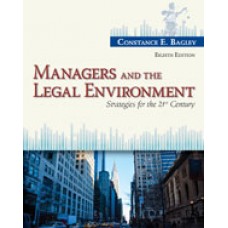
Product details:
- ISBN-10 : 1285860373
- ISBN-13 : 978-1285860374
- Author: Constance E. Bagley
Demonstrating the law’s impact on daily business decisions and long-term strategies, Bagley’s MANAGERS AND THE LEGAL ENVIRONMENT: STRATEGIES FOR THE 21ST CENTURY, 8E equips you with the legal knowledge and risk management techniques essential for success as a business manager. Renowned for its cutting-edge coverage and strategic approach, this book offers one of the most comprehensive yet easy-to-understand presentations of today’s global legal environment of business. In-depth cases help you sharpen your critical thinking skills, and “A Manager’s Dilemma” feature challenges you to consider such issues as whether to outsource labor to a country known for poor working conditions and the ethics of structuring a business to avoid domestic taxes. Whether you have significant management experience or are studying business for the first time, you will learn how to use principles of law to minimize risk and create value, attain core business objectives, identify and resolve legal issues, and effectively handle legal disputes. Up-to-date coverage includes the regulation of commercial speech, the disclosure of corporate political spending, the application of the Fourth Amendment to cell phone location data, the patentability of human genes, employees’ use of social media, regulatory responses to climate change, the fiduciary duties of managers of limited liability companies, the FCC’s proposed rules on net neutrality, the constitutionality of Obamacare, the use of race in college admissions, the Defense of Marriage Act, NSA surveillance programs, the right of college football players to unionize, and more.
Table of contents:
- Unit I: Foundations of the Legal and Regulatory Environment
- Ch 1: Law, Value Creation, and Risk Management
- Ch 1: Introduction
- Ch 1: Chapter Overview
- 1-1: The Systems Approach to Business and Society
- 1-2: Law and Public Policy
- 1-3: The Legally Astute Manager
- Ch 1: Key Words and Phrases
- Ch 1: Questions and Case Problems
- Ch 2: Ethics and the Law
- Ch 2: Introduction
- Ch 2: Chapter Overview
- 2-1: The Relationship Between Law and Ethics
- 2-2: The Ethical Tone Is Set at the Top
- 2-3: The Ethical Business Leader’s Decision Tree
- 2-4: Individual Responsibility
- 2-5: Failing to Meet Societal Expectations
- 2-6: Positive Action
- 2-7: Promoting Ethical Behavior
- 2-8: Honor or “The Morals of the Market Place”?
- Ch 2: Key Words and Phrases
- Ch 2: Questions and Case Problems
- Ch 3: Sources of Law, Courts, and Dispute Resolution
- Ch 3: Introduction
- Ch 3: Chapter Overview
- 3-1: How to Read a Case Citation
- 3-2: Sources of Law
- 3-3: The U.S. and State Court Systems
- 3-4: Federal Jurisdiction
- 3-5: Federal Courts
- 3-6: State Courts
- 3-7: Standing
- 3-8: Personal Jurisdiction
- 3-9: Choice of Forum, Waiver of Right to Trial by Jury, and Choice of Law
- 3-10: Alternatives to Litigation
- 3-11: Class Actions
- 3-12: Civil Procedure: Litigation Steps
- 3-13: Alternative Dispute Resolution
- 3-14: Negotiation
- 3-15: Mediation
- 3-16: Arbitration
- 3-17: ADR Hybrids
- 3-18: Discovery
- 3-19: Document Retention and Deletion
- 3-20: Attorney–Client Privilege, Attorney Work-Product Doctrine, and Other Privileges
- Ch 3: Key Words and Phrases
- Ch 3: Questions and Case Problems
- Ch 4: Constitutional Bases for Business Regulation
- Ch 4: Introduction
- Ch 4: Chapter Overview
- 4-1: Structure of Government
- 4-2: Separation of Powers
- 4-3: Supremacy Clause and Preemption
- 4-4: Federalism
- 4-5: The Commerce Clause
- 4-6: Federal Fiscal Powers
- 4-7: Protection of Individual Liberties
- 4-8: Freedom of Speech and the Press
- 4-9: Right of Association
- 4-10: Freedom of Religion
- 4-11: The Fourth Amendment
- 4-12: Due Process Under the Fifth and Fourteenth Amendments
- 4-13: Compensation for Takings
- 4-14: Equal Protection
- 4-15: Right to Jury Trial
- Ch 4: Key Words and Phrases
- Ch 4: Questions and Case problems
- Ch 5: Agency
- Ch 5: Introduction
- Ch 5: Chapter Overview
- 5-1: Formation of an Agency Relationship
- 5-2: Types of Agency Relationships
- 5-3: Fiduciary Duty
- 5-4: Agent’s Ability to Bind the Principal to Contracts Entered into by the Agent
- 5-5: Liability for Torts of Agents
- 5-6: Liability of the Principal for Violations of Law by the Agent
- Ch 5: Key Words and Phrases
- Ch 5: Questions and Case Problems
- Ch 6: Administrative Law
- Ch 6: Introduction
- Ch 6: Chapter Overview
- 6-1: How Administrative Agencies Act
- 6-2: Administrative Agencies and The Constitution
- 6-3: Principles of Administrative Law
- 6-4: Judicial Review of Agency Actions
- 6-5: Decision-Making Power of Agencies
- 6-6: Finding an Agency’s Rules and Procedures
- 6-7: Obtaining Documents from an Agency
- Ch 6: Key Words and Phrases
- Ch 6: Questions and Case Problems
- Unit II: The Legal Environment
- Ch 7: Contracts
- Ch 7: Introduction
- Ch 7: Chapter Overview
- 7-1: Basic Requirements of a Contract
- 7-2: Agreement
- 7-3: Consideration
- 7-4: Capacity
- 7-5: Legality
- 7-6: Promissory Estoppel
- 7-7: Precontractual Liability for Failure to Negotiate in Good Faith
- 7-8: Unconscionability
- 7-9: Genuineness of Assent
- 7-10: Statute of Frauds
- 7-11: The Parol Evidence Rule
- 7-12: Changed Circumstances
- 7-13: Contract Modification
- 7-14: Discharge of a Contract
- 7-15: Duty of Good Faith and Fair Dealing
- 7-16: Third-Party Beneficiaries
- 7-17: Remedies
- 7-18: Contracts Relating to Mergers and Acquisitions
- Ch 7: Key Words and Phrases
- Ch 7: Questions and Case Problems
- Ch 8: Sales, Licensing, and E-Commerce
- Ch 8: Introduction
- Ch 8: Chapter Overview
- 8-1: Article 2 of the UCC
- 8-2: Software Licenses
- 8-3: Contract Formation
- 8-4: Statute of Frauds
- 8-5: Electronic Contracts: The Uniform Electronic Transactions Act and the E-Sign Act
- 8-6: Duty of Good Faith Under the UCC
- 8-7: Warranties
- 8-8: Magnuson–Moss Warranty Act
- 8-9: The Passing of Title
- 8-10: Allocation of the Risk of Loss
- 8-11: Right to Reject Nonconforming Goods
- 8-12: Unconscionability
- 8-13: Commercial Impracticability
- 8-14: Remedies
- Ch 8: Key Words and Pharses
- Ch 8: Questions and Case Problems
- Ch 9: Torts and Privacy Protection
- Ch 9: Intrduction
- Ch 9: Chapter Overview
- 9-1: Elements of an Intentional Tort and Defenses
- 9-2: Intentional Torts to Protect Persons
- 9-3: Intentional Torts That Protect Property
- 9-4: Intentional Torts That Protect Certain Economic Interests and Business Relationships
- 9-5: Negligence
- 9-6: Liability of Accountants and Other Professionals to Third Parties
- 9-7: Negligent Hiring and Liability for Employee Recommendations
- 9-8: Strict Liability
- 9-9: Respondeat Superior and Vicarious Liability
- 9-10: Successor Liability
- 9-11: Damages
- 9-12: Equitable Relief
- 9-13: Liability of Multiple Defendants
- 9-14: Privacy Protection
- 9-15: Identity Theft
- Ch 9: Key Words and Phrases
- Ch 9: Questions and Case Problems
- Ch 10: Product Liability
- Ch 10: Introduction
- Ch 10: Chapter Overview
- 10-1: Theories of Recovery
- 10-2: Litigation Strategy and the Availability of Punitive Damages
- 10-3: What Is a Product?
- 10-4: What Makes a Product Defective?
- 10-5: Who May Be Strictly Liable for Product Defects?
- 10-6: Successor, Market-Share, and Premises Liabilit
- 10-7: Product Liability Class Actions
- 10-8: Common Law Defenses
- 10-9: Other Legislative Limits on Liability
- 10-10: Tobacco and “Big Food”
- Ch 10: Key Words and Phrases
- Ch 10: Questions and Case Problems
- Ch 11: Intellectual Property
- Ch 11: Introduction
- Ch 11: Chapter Overview
- 11-1: Patents
- 11-2: Copyrights
- 11-3: Registered Mask Works
- 11-4: Trademarks
- 11-5: Domain Names and Cybersquatting
- 11-6: Trade Dress
- 11-7: Trade Secrets
- Ch 11: Key Words and Phrases
- Ch 11: Questions and Case Problems
- Unit III: Human Resources
- Ch 12: The Employment Agreement
- Ch 12: Introduction
- Ch 12: Chapter Overview
- 12-1: At-Will Employment
- 12-2: Wrongful Discharge
- 12-3: Statutory and Constitutional Protection for Whistleblowers
- 12-4: Fraudulent Inducement
- 12-5: Noncompete and Other Agreements
- 12-6: Tortious Interference with Prospective Economic Advantage
- 12-7: References for Former Employees
- 12-8: Employer Testing and Surveillance
- 12-9: Responsibility for Worker Safety
- 12-10: Minimum Wage, Overtime, and Child Labor
- 12-11: Employee Benefits
- 12-12: Worker Adjustment and Retraining Notification Act (Warn Act)
- 12-13: Immigration Law
- 12-14: Labor–Management Relations
- Ch 12: Key Words and Phrases
- Ch 12: Questions and Case Problems
- Ch 13: Civil Rights and Employment Discrimination
- Ch 13: Introduction
- Ch 13: Chapter Overview
- 13-1: Overview of Civil Rights Legislation
- 13-2: Title VII
- 13-3: Age Discrimination
- 13-4: Disability Discrimination
- 13-5: Family and Medical Leave Act
- 13-6: Veterans’ Reemployment Rights
- 13-7: Affirmative Action
- 13-8: Applicability of Civil Rights Laws to Temporary Workers
- 13-9: The Extraterritorial Reach of U.S. Employment Discrimination Laws
- Ch 13: Key Word and Phrases
- Ch 13: Questions and Case Problems
- Unit IV: The Regulatory Environment
- Ch 14: Criminal Law
- Ch 14: Introduction
- Ch 14: Chapter Overview
- 14-1: Definition of a Crime
- 14-2: Source of Criminal Law
- 14-3: Elements of a Crime
- 14-4: Criminal Versus Civil Liability
- 14-5: Criminal Procedure
- 14-6: Constitutional Protections: The Ex Post Facto Clause
- 14-7: Constitutional Protections: The Fourth Amendment
- 14-8 Constitutional Protections: The Fifth Amendment
- 14-9: Constitutional Protections: The Sixth Amendment
- 14-10: Constitutional Protections: The Eighth Amendment
- 14-11: Nonconstitutional Protections
- 14-12: Federal Sentencing Guidelines
- 14-13: Individual Liability for Criminal Acts
- 14-14: Corporate Liability for Criminal Acts
- 14-15: White-Collar Crime
- 14-16: Other Federal Regulatory and Tax Offenses
- 14-17: Amnesty and Leniency Programs
- Ch 14: Key Words and Phrases
- Ch 14: Questions and Case Problems
- Ch 15: Environmental Law
- Ch 15: Introduction
- Ch 15: Chapter Overview
- 15-1: Overview of Environmental Laws
- 15-2: Administration of Environmental Laws
- 15-3: Standing
- 15-4: The Clean Air Act
- 15-5: The Clean Water Act
- 15-6: Other Federal and State Chemical Regulations
- 15-7: The Resource Conservation and Recovery Act
- 15-8: The Federal Superfund Law (CERCLA)
- 15-9: Environmental Justice
- 15-10: Enforcement Activities and Sanctions for Noncompliance
- 15-11: Management of Environmental Compliance
- Ch 15: Key Words and Phrases
- Ch 15: Questions and Case Problems
- Ch 16: Antitrust
- Ch 16: Introduction
- Ch 16: Chapter Overview
- 16-1: Jurisdictional Reach: Interstate or Foreign Trade and Commerce
- 16-2: Agreements in Restraint of Trade: Section 1 of the Sherman Act
- 16-3: Monopolies: Section 2 of the Sherman Act
- 16-4: Price Discrimination: The Robinson–Patman Act
- 16-5: Mergers: Section 7 of the Clayton Act
- 16-6: Unfair Methods of Competition: Section 5 of the Federal Trade Commission Act
- 16-7: State-Action Exemption
- 16-8: Antitrust Enforcement
- 16-9: The Extraterritorial Reach of U.S. Antitrust Law
- Ch 16: Key Words and Phrases
- Ch 16: Questions and Case Problems
- Ch 17: Consumer Protection
- Ch 17: Introduction
- Ch 17: Chapter Overview
- 17-1: Commissions and Agencies
- 17-2: Food Safety and Labeling
- 17-3: Drugs and Medical Devices
- 17-4: Labeling of Other Products
- 17-5: Broadcasting and the Internet
- 17-6: The Consumer Product Safety Commission
- 17-7: Automobiles
- 17-8: Protecting Privacy and Canning Spam
- 17-9: Unfairness, Deception, and Fraud
- 17-10: State Occupational Licensing
- 17-11: Consumer Credit
- 17-12: Regulation of Virtual Currencies
- Ch 17: Key Words and Phrases
- Ch 17: Questions and Case Problems
- Ch 18: Real Property and Land Use
- Ch 18: Introduction
- Ch 18: Chapter Overview
- 18-1: Forms of Ownership
- 18-2: Transfer of Ownership
- 18-3: Recording Statutes and Title Insurance
- 18-4: Brokers
- 18-5: Acquisitions and Dispositions
- 18-6: Environmental Due Diligence
- 18-7: Preliminary Agreements
- 18-8: Financing
- 18-9: Appraisal Methods
- 18-10: Protective Laws for Borrowers
- 18-11: Commercial Leasing
- 18-12: Environmental Impact Statements and Assessments
- 18-13: Government Regulation of Land Use
- 18-14: Physical Accessibility to Commercial Facilities and Public Accommodations: The ADA and State
- Ch 18: Key Words and Phrases
- Ch 18: Questions and Case Problems
- Unit V: Corporate Governance, Ownership, and Control
- Ch 19: Forms of Business Organizations
- Ch 19: Introduction
- Ch 19: Chapter Overview
- 19-1: Sole Proprietorships
- 19-2: General Partnerships
- 19-3: Joint Ventures
- 19-4: Limited Liability Partnerships
- 19-5: Limited Partnerships
- 19-6: Master Limited Partnerships
- 19-7: Corporations
- 19-8: Limited Liability Companies
- 19-9: Benefit Corporations
- 19-10: Low-Profit Limited Liability Companies
- 19-11: Income Tax Considerations
- 19-12: Agency Lawand Limited Liability
- 19-13: Partnership Mechanics
- 19-14: Limited Partnership Requirements
- 19-15: Incorporation
- 19-16: Piercing the Veil of a Corporation or Limited Liability Company
- 19-17: Management of the Corporation
- 19-18: Structural Changesin a Corporation
- 19-19: Tender Offers and Stock Repurchases
- Ch 19: Key Words and Phrases
- Ch 19: Questions and Case Problems
- Ch 20: Directors, Officers, and Controlling Shareholders
- Ch 20: Introduction
- Ch 20: Chapter Overview
- 20-1: The Business Judgment Rule and the Duty of Care
- 20-2: Duty of Good Faith
- 20-3: Duty of Loyalty
- 20-4: Duty of Candor
- 20-5: Duties in the Context of Mergers, Acquisitions, and Takeovers
- 20-6: Allocation of Power Between the Directors and the Shareholders
- 20-7: Duty of Directors to Disclose Preliminary Merger Negotiations
- 20-8: Executive Compensation
- 20-9: Duties of Controlling Shareholders
- Ch 20: Key Words and Phrases
- Ch 20: Questions and Case Problems
- Unit VI: Securities and Financial Transactions
- Ch 21: Public and Private Offerings of Securties
- Ch 21: Introduction
- Ch 21: Chapter Overview
- 21-1: The Federal Statutory Scheme
- 21-2: SEC Rules and Regulations
- 21-3: State Blue Sky Laws
- 21-4: Definition of Terms
- 21-5: Registration of Securities Offerings
- 21-6: EDGAR and Use of Social Media
- 21-7: Shelf Registration
- 21-8: Reorganizations and Combinations
- 21-9: Exemptions for Offerings by the Issuer
- 21-10: The Private Placement Memorandum
- 21-11: Exemptions for Secondary Offerings
- 21-12: Registration of Public Companies Under the 1934 Act and Periodic Reporting Requirements
- 21-13: Violation of the Registration and Prospectus-Delivery Requirements: Section 12(A)(1) of the 1
- 21-14: Section 11 of the 1933 Act
- 21-15: Section 12(A)(2) of the 1933 Act
- 21-16: Criminal Penalties
- Ch 21: Key Words and Phrases
- Ch 21: Questions and Case Problems
- Ch 22: Securities Fraud and Insider Trading
- Ch 22: Introduction
- Ch 22: Chapter Overview
- 22-1: Overview of Antifraud Provisions
- 22-2: Rule 10b–5
- 22-3: Interstate Commerce
- 22-4: Misstatement or Omission
- 22-5: Materiality
- 22-6: Scienter
- 22-7: In Connection with the Purchase or Sale of Any Security
- 22-8: Reliance
- 22-9: Causation
- 22-10: Calculation of Damages
- 22-11: Statute of Limitations
- 22-12: Regulation AC and Securities Fraud Involving a Publicly Traded Company
- 22-13: Litigation Reform Act Safe Harbor for Forward-Looking Statements
- 22-14: Liability of Secondary Actors
- 22-15: Section 17(A)
- 22-16: SEC Actions
- 22-17: Responsibility of Auditors to Detect and Report Illegalities
- 22-18: Definition of Insider Trading
- 22-19: Application of Insider Trading Rules to Government Officials and Political Intelligence Firms
- 22-20: Mail and Wire Fraud
- 22-21: RICO
- 22-22: Enforcement of Antifraud Prohibitions
- 22-23: Selective Disclosureand Regulation FD
- 22-24: Other Requirements Applicable to Officers, Directors, and Greater-Than-10% Shareholders
- Ch 22: Key Words and Phrases
- Ch 22: Questions and Case Problems
- Ch 23: Debtor-Creditor Relations and Bankruptcy
- Ch 23: Introduction
- Ch 23: Chapter Overview
- 23-1: Loan Agreements
- 23-2: Commercial Loan Categories
- 23-3: Secured Transactions Under Article 9 of the UCC
- 23-4: Equipment Leasing
- 23-5: Guaranties
- 23-6: Subordination
- 23-7: Lender Liability
- 23-8: Special Provisions Applicable to Failed Banks and Other Financial Institutions
- 23-9: Management Duties May Shift When a Company Enters the Insolvency Zone
- 23-10: Overview of Bankruptcy Law
People also search:
Managers and the Legal Environment Strategies for the 21st Century, 8th Edition
Managers and the Legal Environment Strategies for the 21st Century, 8th Edition pdf
Managers and the Legal Environment Strategies for the 21st Century
environmental law for environmental managers
the legal environment of business a managerial approach
legal factors affecting business environment
You may also like…
Solution Manual
Solution Manual for Office Procedures for the 21st Century, 8th Edition, Sharon C. Burton
Solution Manual
Solution Manual for Managers and the Legal Environment Strategies for the 21st Century, 8th Edition


